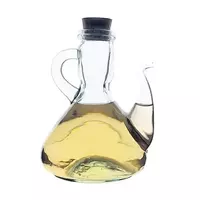Rice vinegar

Over the past few years, with confident steps, rice vinegar has "trampled its path" to the international culinary arena. Therefore, today the amazing fragrant notes of this most common Asian type of vinegar more often and more often can be "read" in a variety of dishes of all kinds of European cuisines.
Despite the fact that rice vinegar almost always contains one raw material (rice wine or fermented rice), three types of this product are currently distinguished: white, red and black. White rice vinegar is made from glutinous rice, so thanks to its tender taste, this product even surpassed the popularity of white wine vinegar from France. The presence of red in vinegar is due to the fact that special red yeast is used when fermenting rice. Its taste and aroma are characterized by fruity sweet-tart shades.
Well, black rice vinegar, which rightfully occupies an important place in Chinese cuisine, consists of a mixture of long-grain and sticky varieties of rice, wheat, barley and rice husks. After seven months of aging, it turns out dark, thick vinegar with a rather rich aroma and taste.
Rice vinegar is just perfect as an aromatic seasoning. It is most often used for marinating fish and other seafood. In addition, it is an important component of a variety of sauces and gravy. This product is wonderfully suitable for dressing all kinds of poultry dishes, as well as salads.
However, when using rice vinegar, it should be borne in mind that the use in various dishes directly depends on its type. So, in black rice vinegar, meat is usually dipped and added to stew products, while it is customary to supplement soups, noodles and dishes from the gifts of the sea with red seasoning. As for the white option, it is great for making sashimi and sushi, marinating fish, and is also an essential ingredient in Soonomono Oriental salad dressing.
Composition of rice vinegar
Due to the presence of a considerable amount of amino acids, the natural product, in addition to being an excellent food seasoning, is also an effective healing agent. Japanese scientists have found that rice vinegar contains a number of essential amino acids - histidine, leucine, valine, lysine, phenylanine, isoleucine and arginine.
In addition, due to fermentation processes, rice vinegar also contains some minerals and vitamins. Thus, regular consumption of small amounts of this popular dressing in the East improves digestive processes and strengthens the protective functions of the body, which indicates the undoubted benefits of rice vinegar.
rice vinegar 54 kCal
Energy value of rice vinegar (Ratio of proteins, fats, carbohydrates - ju):
Proteins: 0.3 g (~ 1 kCal)
Fats: 0 g (~ 0 kCal)
Carbohydrates: 13.2 (~ 53 kCal)
Energy ratio (bj | y): 2% | 0% | 98%
 Español
Español Français
Français Português
Português Русский
Русский 简体中文
简体中文 繁體中文
繁體中文 日本語
日本語 한국어
한국어 العربية
العربية Türkçe
Türkçe Қазақ
Қазақ Deutsch
Deutsch Italiano
Italiano Українська
Українська
